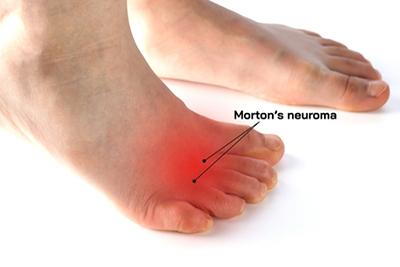
Morton’s Neuroma refers to a thickening of the tissue surrounding the nerve between your toes when it has become either injured or irritated. According to Dr. Anoosh Moadab of All Valley Podiatric Group in Fresno, CA, this condition, which is non-cancerous, creates foot pain that feels like there is a pebble in your shoe.
Morton's Neuroma: Causes
This neuroma is created when a small nerve (such as the common plantar digital nerve – the nerve responsible for sensing the webspace between the toes) becomes squeezed or irritated. Essentially, the nerve becomes trapped and squeezed because it runs beneath the transverse intermetatarsal ligament (near the ball of the foot) – which is essential to support the foot’s forefront.
The consistent nerve pressure causes irritation, and when chronic, it can result in a thickening (fibrosis) of the nerve, which generates even more intense pain. The pain from Morton’s neuroma can become so intense that it prevents weight-bearing and even walking.
This common foot condition primarily impacts women who are 50+ or anyone who walks or exercises a lot (although women outnumber men 4 to 1). Factors that may make the development of Morton’s neuroma more likely include –
- Wearing narrow/ill-fitting/high-heeled shoes is a frequent problem, so choose footwear that provides sufficient space for your feet and toes.
- Certain sports – especially those that require specialized tight-fitting footwear, like those needed for skiing.
- High-impact activities – examples that put added pressure (and cause the nerve to thicken) on your foot such as jogging or running.
- Foot deformities – examples include bunions, hammer toes, flat feet, etc., which may compress the ligament.
Morton's Neuroma: Symptoms and Diagnosis
Morton’s neuroma symptoms usually happen on one side of the foot – most often between the third and fourth toes.
However, the pain (including tingling and numbness) generated from Morton’s Neuroma has the potential to extend outwards or even involve the whole side of the affected foot and toes. The lump caused by the condition is generally small and likely not easily detected or felt; however, you may feel a burning pain near the front of your foot – including the toes, which is persistent and often intense.
The pain will likely worsen when engaged in an activity or wearing poor-fitting shoes. However, the condition can be tricky because the symptoms can be intermittent, with some experiencing multiple attacks and then none for a year or more.
There are a variety of non-surgical options, like supportive shoes; however, more aggressive treatments may be necessary if necessary.
Contact a Leading Fresno, CA, Podiatrist Today
For more information, contact Dr. Moadab or a staff member at All Valley Podiatric Group at 559-436-1213 or online.